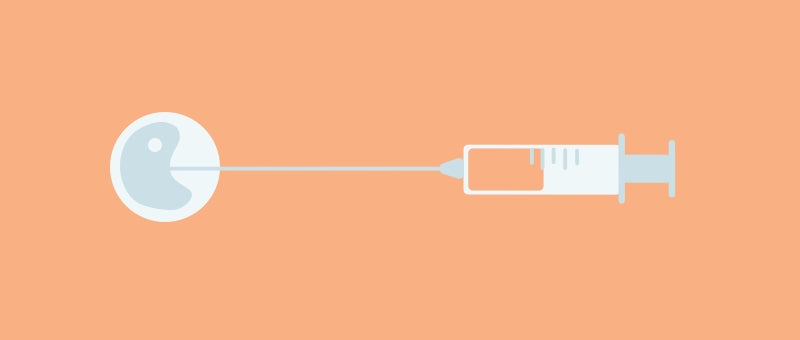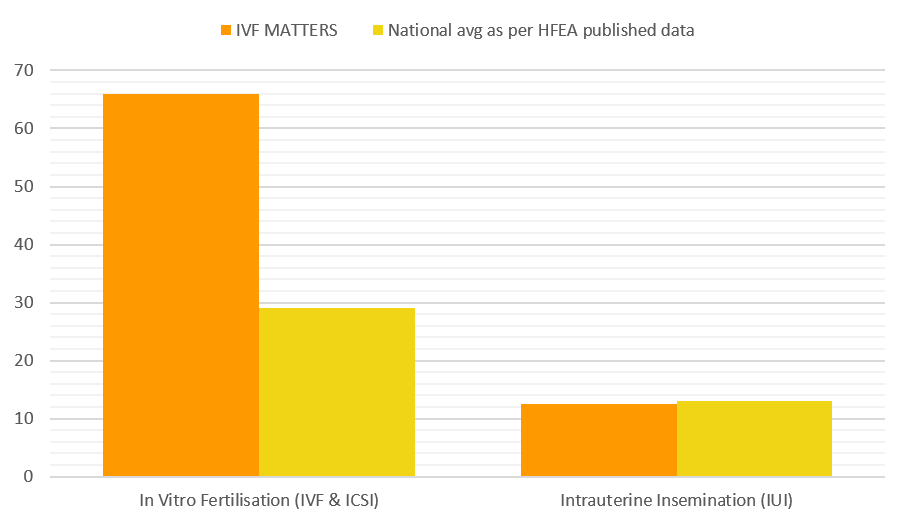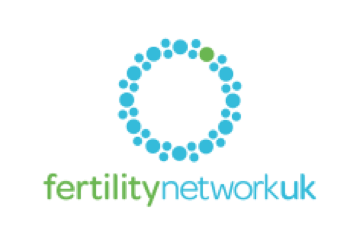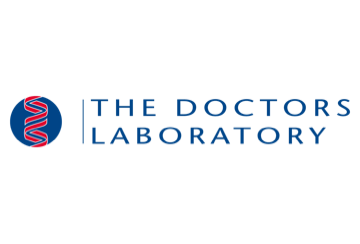We've featured in




Fertility Treatment in London
At IVF Matters, our female-consultant-led care combines medical expertise, personalised treatment protocols, and compassionate support to help you achieve your dream of becoming a parent.
Our services

Ovulation Induction
Infertility in women often stems from anovulation, where eggs fail to release from the ovaries. Ovulation induction addresses this issue by using medications to stimulate ovulation. It's particularly beneficial for women with irregular or absent periods.

Intrauterine Insemination (IUI)
Intrauterine insemination (IUI) is a non-invasive fertility treatment involving the injection of a filtered sperm sample into the uterus during natural ovulation. It's suitable for couples facing conception challenges and allows for the use of partner or donor sperm. Unlike IVF, IUI promotes natural fertilisation within the body, offering a less invasive option.

In Vitro Fertilisation (IVF)
IVF treatment (In Vitro Fertilization) is a highly advanced fertility solution that helps couples and individuals overcome infertility challenges to achieve pregnancy. This cutting-edge reproductive technology involves fertilizing eggs with sperm in a laboratory, offering hope for those struggling with natural conception.

Frozen Embryo Transfer (FET)
Frozen Embryo Transfer (FET) offers a promising route to pregnancy by implanting a previously cryopreserved embryo into the womb. It can be conducted naturally or medicated, tailored to individual needs. A pregnancy test is scheduled post-implantation.

Genetic Testing of Embryos (PGT)
Preimplantation Genetic Testing (PGT) serves as a valuable addition to IVF treatment, assessing embryo genetic material for abnormalities before implantation. While PGT is generally safe and accurate, with approximately 98% precision, prenatal testing is still recommended.

Egg Freezing
Egg Freezing, or oocyte cryopreservation, uses a short course of hormonal stimulation to encourage the ovaries to produce multiple eggs, which are then retrieved in a minimally invasive procedure and vitrified for long-term storage, offering the option to use their own eggs when ready to conceive.

Male Subfertility
Male Subfertility arises from abnormalities in sperm count, motility, or morphology that reduce the likelihood of conception. Diagnostics begin with a semen analysis and hormonal profiling; treatments range from lifestyle optimisation and medical therapy to surgical correction and assisted reproductive techniques such as IUI, IVF, or ICSI.

Female Subfertility
Female Subfertility involves factors like ovulatory disorders, tubal blockages, endometriosis, or uterine anomalies that impair natural conception. Assessment may include pelvic ultrasound, hysterosalpingography, and hormone testing, with personalised treatment plans to address the underlying cause and maximise the chances of pregnancy.
There are many fertility treatments available today—each varying in complexity, cost, and success rates. Choosing the right one depends on your individual diagnosis, goals, and medical history.
Working with a specialist is the best way to decide the most suitable pathway for you.

Meet Dr Irfana Koita
Our Medical Director Dr Irfana Koita takes the time to get to know her patients and their specific needs. This personal attention by the physician is the number 1 rule of our clinic.
Dr Koita is a fellow of the prestigious Royal College of Obstetricians and Gynaecologists (FRCOG) and trained in Assisted Conception at Kings College Hospital, London. She has also done a Masters in Healthcare Leadership from Cornell University, USA. With over 18 years of clinical experience, she’s recognised nationally as an expert in her field.
Learn more about Dr Koita on Doctify and Top Doctors.

Celebrating our high success rates
Let's Make Parenthood a Reality Together
We are dedicated to helping you overcome challenges preventing you from getting pregnant naturally or using assisted reproductive technology like in-vitro fertilisation (IVF). This graph displays our live birth rate for 2021 for all ages.
A NEW WAY TO PAY FOR FERTILITY TESTS AND TREATMENTS
Buy Now Pay Later
Payments in instalments. Soft credit checks! Quick applications! Select at checkout.
Start your exciting fertility journey
The best way to start your fertility journey with us is to start with a conversation.
How It Works
FAQ
There are a number of things you may want to consider before starting a fertility treatment.
The expertise and reputation of the consultant plays a pivitol role as this will enhance your chances of getting pregnant.
The success rates are another good indicator of the quality of care.
It’s important that you consider the costs associated with fertility treatment. Fortunately, at IVF Matters we offer various Buy Now Pay Later payment plans to help you spread the cost in small instalments.
The cost of fertility treatment will depend on the type of treatment you need.
Please refer to our Treatment Prices section for further information.
Getting fertility treatment on the NHS is possible, but you must meet specific criteria. This can differ across the UK, depending on the area you live in and the criteria your local integrated care board (ICB) has. To find out what you’re entitled to on the NHS, you will need to speak with your GP or integrated care board for further information.
Waiting lists are also particularly long in many areas for fertility treatment on the NHS, and it can be frustrating to wait for fertility services to be offered.
At IVF Matters, you can receive treatment much sooner. All of our fertility services — whether for treatment or fertility preservation — are open to everyone.
Our fertility clinic prides itself on providing quick, accessible and affordable fertility care for all.
There are many different types of fertility treatment. How they work will depend on the procedure. However, most fertility treatments involve the fertilising of an egg, either in a laboratory or inside the womb.
There are also fertility preservation treatments that can help you preserve your fertility — helping you to have children when the time is right for you.
Fertility treatment can help you to navigate issues and challenges surrounding your fertility, to increase your chances of having a baby.
At IVF Matters, we take pride in providing our patients with the most advanced treatment options available today.
Our fertility consultants are highly trained and experienced in a variety of fertility treatments and technologies — helping our patients to successfully conceive and deliver healthy babies.
- Ovulation induction treatment – a fertility treatment that uses fertility medications to stimulate ovulation to increase the chances of conceiving.
- Intrauterine insemination (IUI) – this non-invasive treatment involves artificially inseminating a sample of filtered sperm in time with natural ovulation. IUI can be used for heterosexual couples, same-sex couples, and single women. It can also help couples who are unable to have intercourse due to health issues.
- In vitro fertilisation (IVF) – one of the most well-known fertility treatments, IVF has successfully helped many individuals and couples have a baby. IVF involves fertilising an egg with sperm in a laboratory. The resulting embryo is then returned to the woman’s womb to grow and develop.
- Embryo testing: preimplantation genetic testing (PGT) – is a type of IVF treatment add-on in which the genetic material of the embryos is assessed for genetic problems prior to implantation, to increase the chances of having a healthy, successful pregnancy.
- Frozen embryo transfer (FET) – a treatment in which a previously frozen embryo is transferred into the womb.
- Fertility preservation treatment – Fertility preservation involves the freezing and storing of eggs and/or sperm or embryos so that they can be used at a later date.
If you’re struggling with fertility issues or would like to preserve your fertility, we’re here to help you navigate your choices.
The best way to start your fertility treatment journey with us is to book a free advisory call at IVF Matters.
This will give you the perfect opportunity to ask any questions you may have about our approach to fertility treatment and get more information on the specific treatments that we offer.
Your consultant will advise you on the most suitable options for you, as well as the chances for success, depending on your situation. We’re here to give you all the advice, support and treatment you need to increase your chances of having a baby.
Book your consultation today and start your fertility journey.
At IVF Matters, we believe that getting fertility treatment should not be a source of financial stress. We offer world-class technology and treatment options at affordable costs. We are the first fertility service in the UK to offer interest-free payment plans for all our services, including diagnostic tests and our assessment services.
We offer three payment plan options — Splitit, Humm, and Kandoo a new fertility finance plan for diagnostic tests and treatments, e.g. Egg Freezing and IVF Treatment. All options allow you to pay in instalments for the services at our fertility centres.
DIFFERENT TYPES OF FERTILITY TREATMENTS
Take the next step!
Contact Us
Our Location
Our Payment Plans

Monthly payments over 12 months

Monthly credit card payments over 6 months

Monthly payments up to 7 years
Working with








